At the end of the recipe it read “repurpose the whey”. What exactly do those instructions mean? Time and time again I ran across the phrase when researching methods of home cheese making. But, more on whey later…
Specifically, I was looking for a good (easy) method of producing my own ricotta. Too many of the commercial ricottas seem tasteless to me and their textures owe a lot to added gelatines. I wanted something smooth, something that tasted of fresh dairy.
What I produced is not true ricotta. Ricotta is technically a “whey cheese” made from boiling the leftover liquid (the whey) after the cheese curds are removed. And, because I used a portion of high-fat cream along with the whole milk, I got something more like a cross between ricotta and creamy mascarpone.
Homemade Ricotta-Mascapone
This is incredibly easy to do – all you need is a few simple ingredients and an inventive way of suspending the bag of curds over a bowl to collect the whey.
- 6-1/2 cups organic whole milk
- 3 cups heavy cream
- 1 teaspoon sea salt
- 3 lemons
In a large non-reactive pot, mix the milk, cream, and salt. Heat the mixture on medium, stirring frequently, until it reaches the point just before boiling – about 15 minutes. It will shimmer just below the surface. (Warning – do not attempt to write your blog post while the milk/cream is heating as it may inadvertently boil over!) Remove from heat.
Juice the lemons and add to the milky mixture. Stir gently and let it stand for about five minutes.
The acid in the lemon juice will cause the warm mixture to curdle – separating the soft curds and the liquid, the slightly cloudy yellowish whey.
Line a colander with a clean, cotton cloth and place the colander inside a larger bowl. I prefer using a heavier cloth than cheesecloth (for which you will need several layers). You could purchase a specialist butter muslin or I have even seen large men’s cotton handkerchiefs recommended (obviously new, not used!). I’ve recycled an old 100% cotton pillow slip for the purpose. Pour the curds and whey into lined colander. Allow most of the whey to drain into the bowl.
Gather up the ends of your cloth and tightly tie them with a piece of string. Hang the bag of dripping curds and suspend it over the bowl of whey. I suspend it from my grandfather’s old wooden clamp attached to the kitchen table.
Let it drain for at least an hour, if not longer for a firmer curd (timing will depend on the porosity of your cloth). Remove the cheese from the bag. Use immediately. Or, it can be refrigerated for a few days or even frozen for future use.
Oh yes, final instructions: repurpose the whey.
Notes on Repurposing Whey:
In my internet searches, I found a number of novel ways to use the whey (instead of pouring it down the drain). The type of whey produced here is acid or sour whey, which is what you get when using lemon or vinegar to curdle. Sweet whey is produced when rennet cheeses are made. The top three uses (in my opinion) for sour whey are the following:
- Use it in place of water in baking. It is particularly good in baking bread and can even be used to pre-soak groats or other grains added to bread. It also enhances the sourness in sourdough breads. This is my favorite method of repurposing the whey.
- Use it as a plant food for acid loving plants. I use it on my blueberry bushes during the growing season.
- Use it to soak dried beans. It is said to reduce the flatulent properties of the beans. I have not yet tried this, so cannot tell you if it is true!
No excuses: repurpose the whey!
Postscript: Have any of you seen the news about the oldest (almost 4,000 years old) piece of cheese found with a mummy in the Taklamakan Desert of northwest China? Read all about it on The History Blog.
Update on Repurpose the Whey
While the Ricotta-Mascarpone came in handy for sweet dessert making, I still was in search of a ricotta I could use with savory dishes like lasagne or as stuffing for homemade ravioli. I experimented using semi-skimmed milk (9-1/2 cups total) instead of the whole milk and the cream in the recipe above. The resulting ricotta was creamy and looked like standard ricotta (though it tasted better!) rather than a fuller fat mascarpone. However, I noticed that the amount of ricotta cheese produced was less (almost half) than the ricotta-mascarpone above. Also, proportionally, there was much more whey – good news for bread making, but it required a larger bowl to catch the dripping.
I now feel that I have two wonderful methods of making my own ricotta – two different fat contents for different purposes. I’ve also had a number of useful suggestions for other ways to repurpose whey.
Add three more uses of whey to the list:
4. Whey is recommended to begin fermenting vegetables – perfect for kimchi, sauerkraut, etc.
5. Even though it is sweet whey that often recommended as a drink, I’ve tried the sour whey chilled. As its name implies, it is slightly sour, but would be refreshing with a little sweetener (optional) and bashed sprigs of mint.
6. Use as an additive in soups. The type of soup depends on its ability to accommodate the sour taste of the whey.
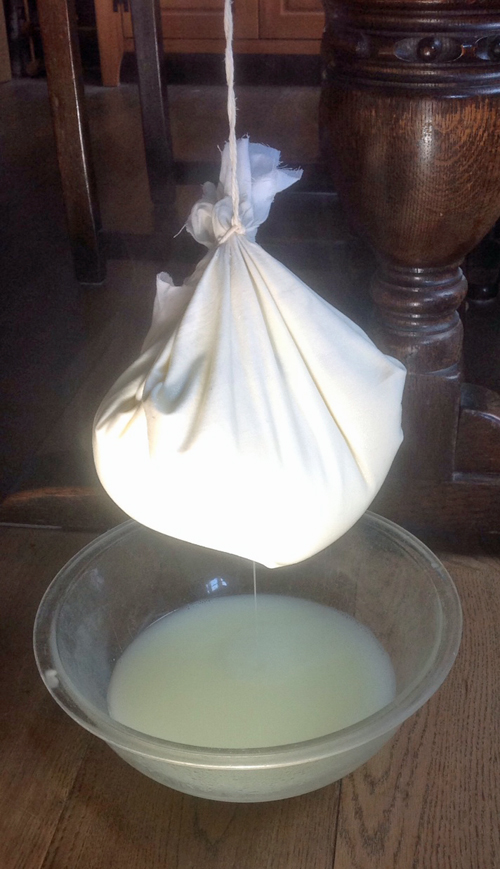
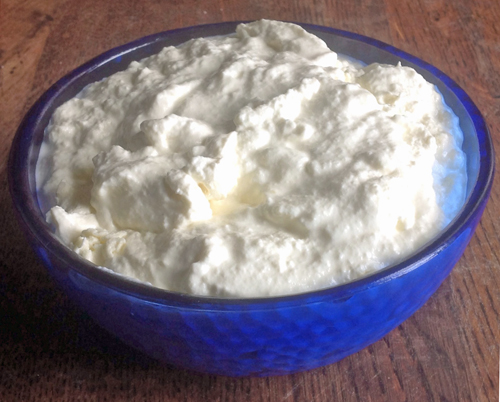
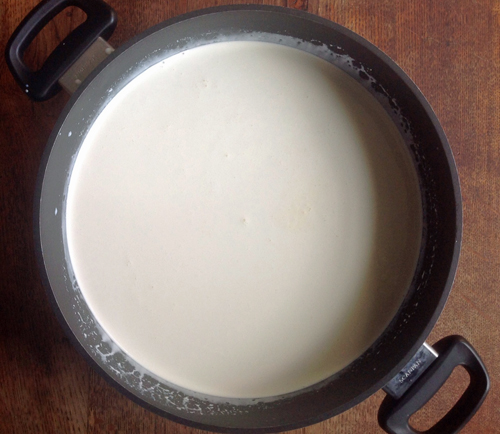
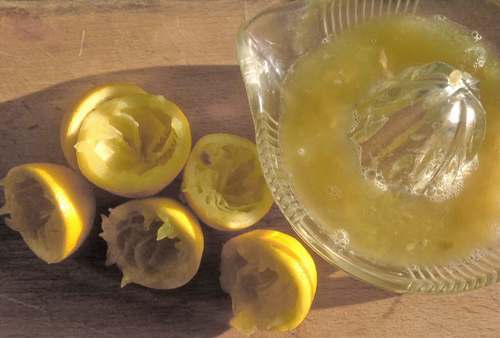
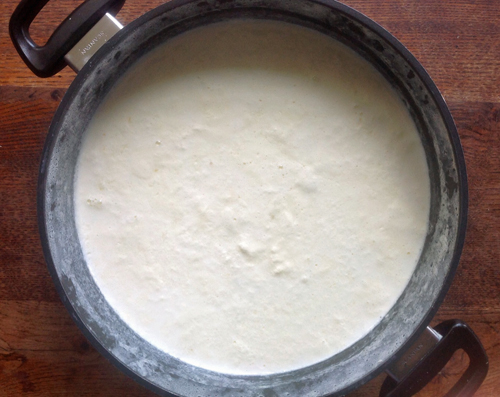
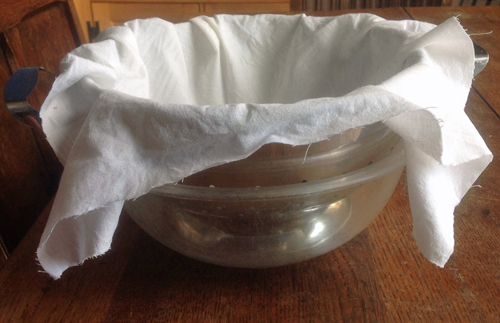

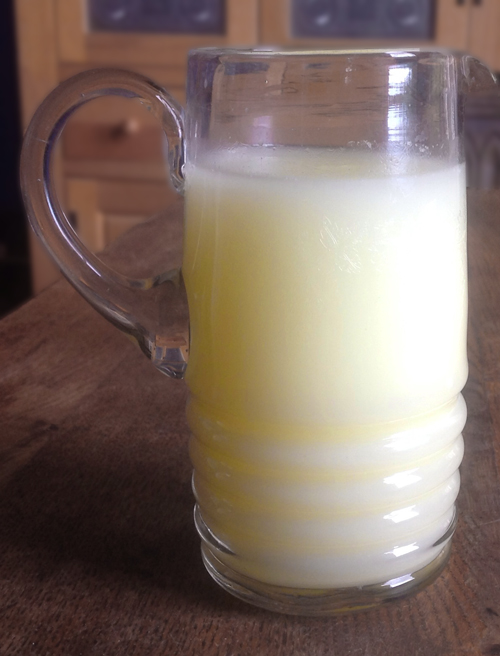
I have taken part in ricotta making demo, using just milk and lemon juice, heated then when coagulation occurs, the curds are lifted out of the whey and left to strain. It was sweet and delicious! Love the repurposed whey suggestions. For a while I was making yoghurt with lactose free milk and it always needed hanging to thicken it. I was odds at what to do with the whey and generally ended up discarding it. So have to ask, what did you make with your cheese?
LikeLike
I used some of it with chestnut pancakes (necci) – the next post! I need to try half-fat milk and lemon to make something more like ricotta. The whey is absolutely marvellous in bread. I’m tempted to keep making cheese just to get my hands on the whey.
LikeLike
Just a thought on yoghurt – the thick Greek yoghurt is called “strangismeno” which means strained. In the past, I’ve seen bags of dripping yoghurt in many households on rural Greece. They collect the whey, but I never asked what they did with it. Will need to inquire…
LikeLike
I have a Maltese friend staying this weekend. He often makes cheese so I asked him about the whey. He says it’s used just as a drink, has many health benefits and was a highly coveted treat when he was a kid.
LikeLike
That’s wonderful. Thanks for the information. I, too, ran across mention of whey as a drink, but it was recommended for the sweet whey only, not the sour. I’m now wondering if the sour whey might make an interesting drink. Another blogger mentioned whey chilled with sprigs of mint (a cheesy, non-alcoholic mojito? 😉).
LikeLike
I have not tried the recipe with the whey to make ricotta from “Cheesemaking Made Easy” by Ricki & Robert Carroll, but it specifies using cider vinegar instead of the lemon juice….not sure how this would affect the outcome. They also suggest that whey is delicious in bread baking, soup stock and as a “refreshing summer drink” served with ice and crushed mint leaves. If none of this appeals to you, they suggest it makes an “excellent feed for pets, and livestock such as chickens or pigs” !
LikeLike
Thanks for the tip on the book (not surprising given the source!). I saw similar tips of using whey in soups and as a drink, but these things were for specified for sweet whey, not sour whey. There were also cosmetic uses for sweet whey, like as hair conditioner. I haven’t tried making cheese with rennet, but it’s only a matter of time. Alas, no pigs or chickens in my small back garden.
LikeLike
Thank you for this post! I am really excited now to try your ricotta method. I actually cannot buy ricotta in our town– have to go to a big supermarket a half hour drive away. Following on your wonderful pancake post, there is a marvelous Marcella Hazan Ricotta Pancakes recipe (lemon zest, serve with honey) that I have been craving to make.
An additional whey-repurposing: use it to begin fermenting vegetables– this is the Sally Fallon approach in her book Nourishing Traditions.
LikeLike
Oh, that sounds like a good suggestion for repurposing whey. Must add it to the list. I’m going to experiment with half-fat milk (no cream) next time to see if I get something more approaching ricotta. Although, this ricotta-mascarpone version is really great for sweets – cheesecakes, tiramisu, etc.
LikeLike
Wow, a cross between ricotta and mascarpone sounds amazing!! And I love ‘repurposing’ I reckon I do that a lot!!
LikeLike
Yes, you do, indeed, repurpose a lot! The ricotta-mascarpone was smooth and creamy, but not as dense as store-bought mascarpone. I think it would be great in sweet desserts. At the moment I’m experimenting with semi-skim milk to get a ricotta that can be used with savoury things, like lasagne or in homemade ravioli.
LikeLike
Cool, that’s sounds interesting too!!
LikeLike
In bread, why didn’t I think of that? Thank you! Such a great post and I love the new look of your blog.
LikeLike
Thanks! I really love it in bread – particularly with seeded whole wheat and also in rye. I haven’t tried it in plain white yet, but it’s on the list.
LikeLike
I too make my own ricotta and have always hated throwing away all that whey when I’m finished. Your post has been so helpful. I don’t know much about gardening and fear that I have the black thumb of death more than anything else, but can definitely see myself using it for break making and soaking beans. Thanks for the info!
LikeLike
Whey is really wonderful in breads. I still need to try it with bean soaking. I also keep the whey refrigerated and try to use it up within a few days. I have no idea how long it lasts, but I would think it is a bit like milk.
LikeLike
I just had a great education reading both your post and all your fabulous comments. Love blogging!
LikeLike
Doing an update on the post tomorrow – experiments with semi-skimmed milk. It’s all a work in progress! I learn a lot from blogging, too.
LikeLike
– Yes, I saw the news about the oldest (almost 4,000 years old) piece of cheese found with a mummy in the Taklamakan Desert of northwest China. Isn’t that amazing!
– I too am amazed by a cross between ricotta and mascarpone cheese. I love both cheeses and it must be wonderfully delicious.
– We use whey in Persian cooking (especially to mix with vegetable soups). It comes in thick, creamy, white opaque form, and I don’t know how it is made, and it does not have any hint of sour taste.
LikeLike
– I love hearing about cultural traditions! Do you distinguish between sweet and sour whey? Many of the sources I consulted recommended different uses for each type. From your description, I think you are referring to sweet whey – i.e. what remains after making rennet-based cheeses. Yes, those sources I consulted did indicate that sweet whey was added to soups and even stews.
– We have friends who are studying the earliest milk, yoghurt and cheese production in the Neolithic period, so the China discovery was very interesting and significant.
LikeLike
[…] ← Repurpose the Whey […]
LikeLike
This is very similar to the process that paneer is made by in India without the addition of the cream. Great ideas for whey. Here’s another — bottle it and sell it has ‘Whey Protein’. Make a buck or two.
LikeLike
Good idea! Would love to make paneer, one of our favourites especially with spicy spinach! The whey in bread was a revelation. I suspect it is something like using buttermilk.
LikeLike
Fantastic! Great post, I have been thinking about cheese making for a while and now I am all up on the whey!
LikeLike
I’ll have to branch out i to other types of cheeses -at least the easy ones. I have no patience for anything complicated. My favourite use of the whey is still in bread making – add something to the finished texture and taste.
LikeLike
Well when I get back into a kitchen with utensils I’ll let you know if I come across some interesting and easy ones.
LikeLike
Let me know! Paneer was suggested…
LikeLike
I’m “studying” to make cheese at home and you inspired me even more with this useful post on how to use the whey!… I knew about the ricotta but anyway it’ s good to read about real experiences and results!
LikeLike
I’m experimenting with cheese making, too. It seemed such a waste to throw away all that whey, so I did a little bit of research and tried a few of the suggestions. My favourite is still in bread making.
LikeLike